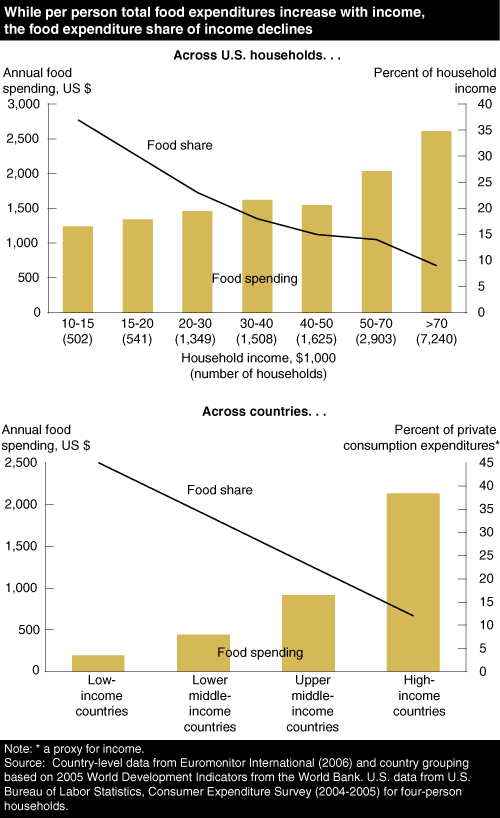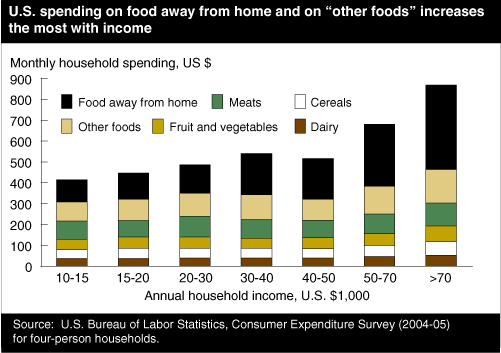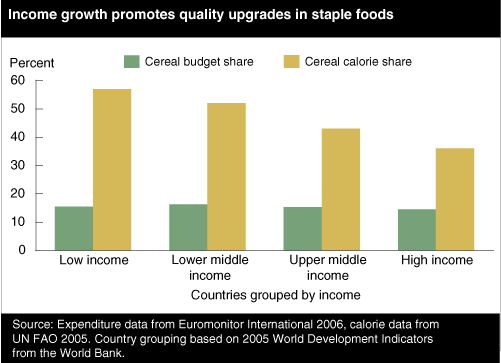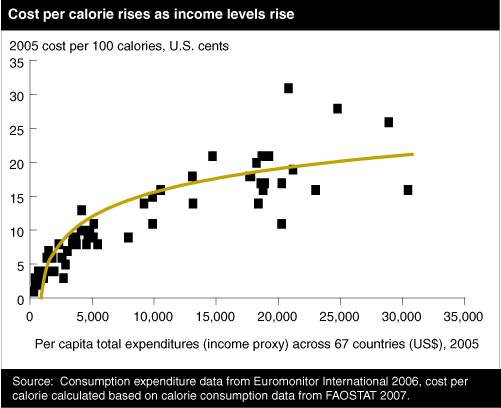Converging Patterns in Global Food Consumption and Food Delivery Systems
- by Elizabeth Frazão, Birgit Meade and Anita Regmi
- 2/1/2008
Highlights
- Across countries and income levels worldwide, consumers are choosing to spend their additional income on some combination of increased quality, convenience, and variety of foods.
- Food delivery systems and consumption patterns in middle-income countries like China and Thailand are converging, or 'catching up' to countries with higher income levels.
- Income growth has been a primary force behind converging global consumption patterns, but globalization of the food industry is also contributing.
With rising income levels and global expansion of food retailing and foodservice outlets, food consumption patterns, as measured by spending on different types of food products, appear to be converging across countries. Food products and multinational retail and foodservice chains from the U.S. and other high-income countries have become increasingly common in middle-income nations such as China and Thailand. For example, fast food sales in China more than doubled between 1999 and 2005, while sales from Western-style supermarkets increased almost sixfold, from $16 to $91 billion during the same period. Changes in food preferences and food delivery mechanisms appear to be mutually enforcing, with worldwide tastes and diets evolving along with increasingly modern food retailing and foodservice outlets. This cyclical relationship between food demand and delivery mechanisms is increasing the similarity of food delivery and consumption around the world—a phenomenon referred to as “convergence.”
Food Budget Shares Decline as Incomes Increase
The share of income or private consumption expenditure (PCE) spent on food is often used as an indicator for the relative well-being of a country. The difference between income and PCE is that income includes household savings. In poor countries, households tend to spend a large share of their incomes on food, leaving less income for other essential items such as health care, housing, education, and fuel. Households in high-income countries spend a relatively low share of PCE or income on food, which leaves sufficient income for other essential items, as well as recreational and cultural activities. According to Euromonitor data, in the U.S., for example, at-home food spending accounts for less than 10 percent of PCE, compared with China, where it accounts for 26 percent.
Similarly, within a country, although spending on food increases as income levels increase, the proportion of total income devoted to food declines. This phenomenon is known as Engel’s Law, after the 19th century German statistician Ernst Engel. The intuition behind Engel’s Law might be described as a “food first” budget allocation. Even low-income households must devote at least a minimum amount to meet the basic need for food. As income increases, households may spend some of that additional income on food, but will allocate proportionally more on other, nonfood items. For a given gain in income, the increase in food spending is larger at lower income levels than at higher income levels. This explains why, as incomes rise in lower income countries, their food expenditures tend to catch up with those of higher income countries.
Analysis of 2004-05 consumer expenditure data confirms the trend in declining food budget shares for the U.S. (see box, “Analysis Required Data From Several Sources”). Among four-person households, total food spending—including food away from home—is slightly over $2,500 per year among the highest income group, roughly double that of the lowest income group. However, average annual after-tax income in the highest earning households is more than eight times that of the lowest income households ($116,290 versus $13,290). Thus, the share of income devoted to food declines from 37 percent for the lowest income households to 9 percent for the highest income households, reflecting Engel’s Law.
A similar trend in declining food shares is noted across country groups with varying average income levels. Euromonitor International’s annual per capita food spending data (not including food away from home) for 67 countries, revealed that food spending increases from less than $200 per capita per year in low-income countries to $2,133 in high-income countries, while the food share of PCE decreases from 42 percent in low-income countries to 12 percent in high-income countries.
Increased Food Spending in the U.S. Favors Increased Quality, Variety, and Convenience
In the U.S., the rise in food spending as income increases is driven largely by food away from home, which captures two-thirds (65 percent) of the more than $450 increase in monthly household food spending between the lowest and the highest income groups. The highest income households spend nearly half (47 percent) of their food budget on food away from home, almost double the share among the lowest income households.
Among at-home foods purchased in grocery stores, spending on “other foods” rises the most with increases in income. This category includes high value-added foods such as frozen prepared meals, canned and packaged foods—including a variety of novel and ethnic products—snack foods, and nonalcoholic beverages, in addition to condiments, sugars and sweets, and fats and oils. Spending on “other foods” increased from $92 per month for the lowest income U.S. households to $161 per month among the highest income households. Interestingly, households in all income categories consistently spend the largest share of their food budget on “other foods,” followed by meats, fruit and vegetables, cereals and bakery products, and dairy products.
In contrast with the increased spending on “other foods,” spending on meats, cereals and bakery products, and dairy products remains fairly steady across household incomes until incomes reach $50,000 per year.
Similarly, U.S. spending on fruit and vegetables rises only minimally across income levels. Households in the highest income group—which have an average of $8,000 more in after-tax monthly income than households in the lowest income group and spend over $450 more on food—choose to spend just $26 more per month on fruit and vegetables, which translates into an additional 21 cents per person per day on fruit and vegetables. The small change in spending on fruit and vegetables may explain why many high-income households also fail to meet intake recommendations for fruit and vegetables, and suggests that income and prices are not likely the main factors behind the low consumption of fruit and vegetables among low-income households, as is commonly believed.
The dramatic increases in spending on food away from home and “other foods” suggest that, as income increases, U.S. households seek qualities such as taste, variety, convenience, and enjoyment. Whereas this may sometimes occur at the expense of greater nutritional value, this study is unable to look at changes in the nutritional value of diets in response to income increases.
What Global Food Spending Trends Can Be Observed?
If we compare average food spending of low-income countries with that of middle- and high-income countries, global trends emerge, some of which are comparable to those observed across income groups in the U.S.
As income increases across country groupings, consumers in those countries increase their food spending to purchase more calories, typically in more expensive forms. Per capita consumption averages 2,618 calories per day in low-income countries, 3,000 calories in middle-income countries (a 15-percent increase), and 3,348 calories in high-income countries (an 11-percent increase). Yet, food spending more than doubles from one country group to the next—from less than $200 per capita per year in low-income countries, to $440 in lower middle-income countries, to $914 in the upper middle-income countries, to $2,133 in high-income countries, which is 10 times higher than that of low-income countries—even as its share of income declines.
Lower income countries generally have diets that are high in starchy vegetable components (such as cereals or roots and tubers, which provide mostly carbohydrates) and low in animal products. Although the share of the food budget spent on cereals is similar (15 to 16 percent) across country groups, the contribution of cereals to overall calories decreases from 57 percent in low-income countries to 36 percent in high-income countries. This suggests that consumers in wealthier countries are substituting more expensive, higher quality, and value-added forms of cereals (breakfast cereals and baked goods) for the cheaper domestic staples (cornmeal or rice) to increase the quality, variety, and convenience of their diets.
Conversely, animal products, such as meat and dairy products, are considered a luxury in lower income countries due to their relatively high cost, compared with cereal products. While the meat and dairy food budget shares remain similar across country groups, 22 to 25 percent for meat and 10 to 12 percent for milk, their contribution to overall calories increases with rising income levels. Meat contributes just 4 percent to total calories in low-income countries, 7 and 11 percent in lower and upper middle-income countries, and 13 percent in high-income countries. Milk contributes 5 percent to total calories consumed in low-income countries versus 11 percent in high-income countries. The increased caloric contribution suggests that as income increases, consumers buy more animal products, thereby adding quality and variety to their diets.
The fact that rising incomes across countries bring large absolute increases in food spending but comparatively smaller increases in calorie consumption implies an increase in the cost per calorie. In low-income countries, 100 calories cost an average of 2 cents; the cost doubles to 4.2 cents in lower middle-income countries, doubles again to 8.3 cents in upper middle-income countries, and more than doubles to 17.4 cents in high-income countries.
There are many possible forces at work behind the rise in cost per calorie. Consumers could simply be buying more highly processed forms of food which may not necessarily be higher quality, just more expensive to produce. In this case, they are most likely looking for convenience. However, additional evidence, cited above, suggests that a country’s rise in cost per calorie—which occurs rapidly, at first, and then becomes more gradual—does reflect a demand for some combination of perceived quality (looks, sanitation, flavor, cultural preferences, perhaps even nutritional quality), variety, and convenience. Comparison of food budget shares and the calorie contributions of different food groups suggests that this increase in calorie cost is largely driven by a shift toward more expensive types of calories. Consumers are purchasing greater quantities of more costly foods, such as animal products in lower income countries, or organic produce in higher income countries. They are also buying more value-added forms of foods, and many are even spending money on zero-calorie items such as diet sodas.
In addition, foodservice sales data from Euromonitor International also substantiate a global trend of higher spending on food away from home as income increases. In 2005, annual expenditures on food service averaged $95 per capita in lower middle-income countries, $260 in upper middle-income countries, and $781 in high-income countries. Although the spending levels are lower in middle-income countries, the expenditure levels are growing very rapidly. In the fast food sector, sales have more than doubled in countries such as China and Indonesia, while developed countries such as Japan register slower growth rates of only 6 percent.
International Food Consumption Patterns Are Converging
Income growth, which is associated with increased demand for higher valued foods, is a primary force driving convergence in global diets. Consistent with Engel’s Law, for a given change in income, lower income consumers make bigger changes in food expenditures than do higher income consumers. For example, a 10-percent increase in income is estimated to increase meat expenditures by 1 percent for the average U.S. consumer, but 7 percent for a consumer in a middle-income country such as Thailand.
Larger income-induced changes in lower income countries drive the food consumption trend toward convergence. The term convergence implies a dynamic process—movement from different starting levels toward some common outcome. In the case of food consumption, the common outcome is some universal “ceiling” or “saturation” level of demand for a particular food or food group, which is achieved at high income levels. Convergence can be statistically estimated as the speed of food expenditure changes over time across countries. This speed varies considerably—growth in food expenditures between 1998 and 2005 was as low as 14 percent in Japan and more than 100 percent in Indonesia.
Regression analyses conducted on food expenditure changes point to a high degree of convergence between middle- and high-income countries, particularly for total food expenditures and meat expenditures. Although actual food spending levels are higher in wealthier countries, middle-income countries show faster growth in expenditures. Middle-income countries thus appear to be “catching up” to countries with higher expenditure levels, leading to convergence (low-income countries had to be excluded from this analysis due to lack of reliable data).
Globalization of the food industry, as measured by the expansion of multinational retail and food service chains, is also contributing to converging trends. The last decade has witnessed an unprecedented rise in standardized retail outlets such as supermarkets, convenience stores, and large discount stores in developing countries. For example, supermarkets accounted for 15 to 30 percent of national retail sales of food in Latin America before the 1980s, but 50 to 70 percent in 2001, registering in two decades the level of growth experienced in the U.S. in five decades. The food retail structure in Asia is undergoing similar rapid changes.
Similarly, Western-style restaurants and fast food chains are becoming more prevalent in middle-income countries, where increasingly urban and dual-income household demand for convenient food supports expansion of these outlets.
Whereas local tastes and diets typically determine what products are sold, consumer choices are also being influenced by products sold in these standardized retail and foodservice outlets, which are often owned by multinational companies operating in several countries. As a result, the evolving food delivery system is also contributing toward converging trends in global food consumption patterns.
Regression analysis confirmed converging trends in food delivery systems, as measured by sales from modern standardized retail outlets and the foodservice sector. Food sales through supermarkets and fast food service outlets in middle-income countries are moving toward the levels found in high-income countries.
Convergence analysis also provides an estimate of the “half-life” of progress toward convergence (i.e., the number of years required for progress halfway toward the steady-state level when convergence is assumed to have been achieved). There is remarkable similarity in the half-life estimates—between 16 and 21 years for total food service, standardized retail outlets, and food/meat expenditures across country groupings. Convergence in fast food sales, with a half-life estimate of 9 years, appears to be occurring much more rapidly than for any other type of expenditure. This is not surprising, given that, in the U.S., among all food categories, spending on food away from home showed the largest response to increases in income.
In summary, income growth and globalization of the food retail and foodservice industry are giving rise to increasingly similar food consumption patterns across the world. Food consumption patterns of middle- and high-income countries, as indicated by their food spending across different food types over time, are converging. The expansion of Western-style retail and foodservice outlets is modernizing the food marketing sector in developing countries. At the current rate, ERS estimates that in about 20 years, food purchases in middle-income countries through Western-style grocery stores will approach 50 percent of the level of the sales in higher income countries. Convergence in the foodservice sector is moving faster, with expenditures in middle-income countries expected to reach 50 percent of the level of high-income countries within a decade. However, given ERS research showing that the foods U.S. consumers choose to eat away from home, on average, are higher in calories but lower in nutrients than foods eaten at home, these trends have important implications for obesity and health in developing countries.
This article is drawn from:
- Food Expenditure Series. (n.d.). U.S. Department of Agriculture, Economic Research Service.
- The Influence Of Income On Global Food Spending. (1997). Economic Research Service. in Agricultural Outlook, AO-242. .
You may also like:
- Food Markets & Prices. (n.d.). U.S. Department of Agriculture, Economic Research Service.
- Income and Diet Differences Greatly Affect Food Spending Around the Globe. (1996). Economic Research Service. FoodReview, Vol. 19, Issue 3..
- Processed Food Trade Pressured by Evolving Global Supply Chains. (2005). Economic Research Service. in Amber Waves, Vol. 3, No.1..
We’d welcome your feedback!
Would you be willing to answer a few quick questions about your experience?






